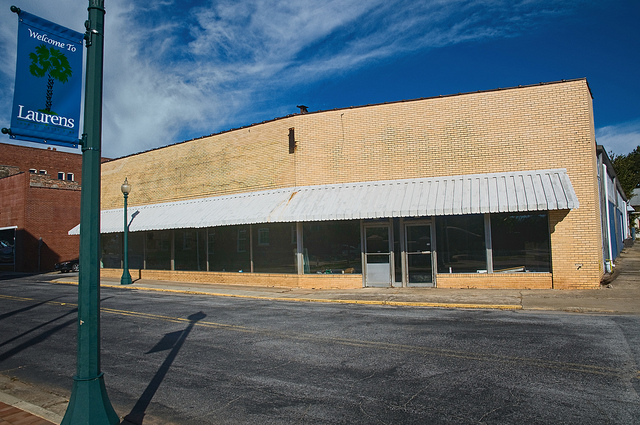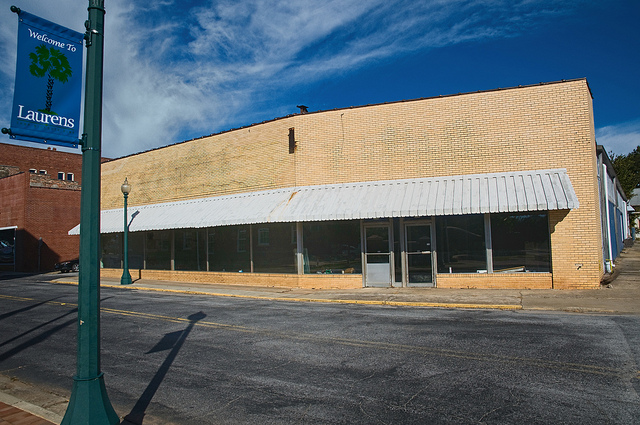 An abandoned Dixie Home Supermarket.Photo: Pete Zarria
An abandoned Dixie Home Supermarket.Photo: Pete Zarria
Driving down a two-lane highway in rural Nebraska last spring, I passed a Native American man riding an old bicycle toward the nearby Omaha Indian Reservation. We were at least seven miles from the nearest town, and he had four grocery bags bulging with food slung over his handlebars as he worked to climb a hill. I’ll bet a week’s worth of groceries that he wasn’t biking for the exercise.
This is what a food desert looks like in rural America.
The term “food desert” has gained a lot of attention in the media in the last several years (much to the chagrin of people who like deserts and don’t appreciate the negative connotation). I’ve also heard “food vacuum” and “area of low food access,” but nothing gives the mental picture of what it’s like to live in a place with no food like “food desert.”
When most people hear “food desert,” they think of places like West Oakland, Detroit, or inner-city Chicago. Personally, I think of places like Harrison, a Nebraska town of 279 people. A resident of Harrison called me for help several months ago because the owners of their local grocery store have gotten sick and need to sell or shut down. If they close, it’s a 50 mile drive to the next nearest grocery store. I’ve had conversations with members of Native American nations who talk about driving 110 miles through a mountain pass to get to their nearest town.
The paradox of our unhealthy food system is that many rural towns lack healthy food access, even as the food we eat is grown in rural places. To put it simply, our current food system is failing the very communities that grow our food.
I consider myself very lucky when it comes to food. I have land on which I can grow vegetables and raise animals, and time to tend them. There’s a grocery store in my town, and I have a good job that allows me to afford to buy what I can’t grow or process myself. I do have an “out of town grocery list” for exotic staples — wasabi, coconut milk, organic anything — but I can certainly live without those things if I needed to.
So how is it possible that people in farm country have a hard time finding food? In short, it’s complicated.
Here are a few of the factors:
- Poverty: Dom Helder Camara once said, “When I give food to the poor, they call me a saint. When I ask why the poor have no food, they call me a communist.” Poverty is a factor nobody wants to talk about. When Midwestern towns had lots of manufacturing jobs, towns of 1,000 could support two or three stores, some of which stayed open 24 hours for customers on second and third shift. Now that those jobs have gone overseas and unemployment is at 10 percent, a lot of people can’t afford food.
- Race: Poverty and race are closely linked. In the two Indian Reservations directly north of where I live, there might be one run-down grocery store, and I wouldn’t be surprised if predominantly white rural towns have more food access than towns with predominantly people of color. This 2006 study came to that conclusion in Washington, D.C.: White neighborhoods averaged one grocery store for 11,900 residents, and black neighborhoods averaged one grocery store for 70,000 residents.
- Geography: The closer a rural community is to a city or a big box store, the less likely it’ll be able to support its own grocery store. People are too tempted to shop elsewhere.
- Community support: Closely linked to geography, if everyone in your town supports the local grocery store (or hardware store, restaurant, or bar), it will survive.
I could go on: Mental illness, lack of entrepreneurs, social stigma, illiteracy, the loss of knowledge of how to grow food — all play into a lack of food access for rural communities.
Food banks and other emergency food assistance do exist, and their task is to address the immediate hunger at hand. But they’re not easy to access even in the rural areas that have them. One of our local food pantries requires two forms of ID to prove you live in the region it serves — I shudder to think that they might turn a homeless person away. And after the holidays, many food banks find their shelves almost bare.
How depressing. What’s a small town to do?
There are lots of ideas out there, from the Rural Grocery Initiative at Kansas State University to federal resources laid out on the Center for Rural Affairs page on rural food access to news stories and inspiring videos about a 17-year-old who saved the grocery store in Truman, Minn.
Rural communities need entrepreneurial skills to start and run a successful business. They also need young and energetic farmers willing to grow food and teach others how to do the same.
Do you have those skills? Are you willing to help? Share any additional ideas you have in the comments!



